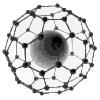
DMT-Nexus member
Posts: 57 Joined: 26-Nov-2009 Last visit: 23-Apr-2024
|
All teks for this reaction I've seen seem to call for "zinc powder". The zinc powder is added to the acidic solution (pH ≤ 3) before basfication, then you have to filter out the excess zinc powder. If the acidic solution is acidified with HCl the zinc powder will form ZnCl2. When doing an A/B, Is there any reason why SWIM couldn't dissolve a larger piece of zinc in more concentrated HCl forming Zinc Chloride (and H2) right away instead. Then he could just add the ZnCl2 and HCl solution to the solution with the alkaloids. Why do all teks call for zinc powder? The owls are not what they seem
|
|
|
|
|

Kalt und Heiß, Schwarz und Rot, Kürper und Geist, Liebe und Chaos
 
Posts: 4661 Joined: 02-Jun-2008 Last visit: 30-Apr-2022
|
Because elemental zinc is a reducing agent. Basically it means that it gets oxidised by reducing another substance. It's valency goes from 0 +2 zero therefore. ZnCl2 is an already oxidised form of zinc (valency =0) and it is not a reducing agent. Mind you, we still do not know what exactly happens during the reduction of the n-oxide. It could be as you said, e.g. Zn +HCl --> ZnCl2 + 2H+, then dmt-n-oxide + 2H+ --> dmt + H2O (likely) or it could be more direct, e.g. Zn + dmt-n-oxide --> ZnO and dmt (less likely). Need to calculate between salts and freebases? Click here! Need to calculate freebase or salt percentage at a given pH? Click here!
|
|
|

DMT-Nexus member
Posts: 57 Joined: 26-Nov-2009 Last visit: 23-Apr-2024
|
Infundibulum wrote:Because elemental zinc is a reducing agent. Basically it means that it gets oxidised by reducing another substance. It's valency goes from 0 +2 zero therefore. ZnCl2 is an already oxidised form of zinc (valency =0) and it is not a reducing agent.
Aha, thank you for clearing that up.  Zinc powder is needed then... I read somewhere that you could make zinc precipate from a ZnCl2 solution by adding Al. I guess the reaction would be to dissolve Zinc in HCl and then evaporate this, leaving the Zinc Cloride in crystal form. Dissolving the crystals in water and adding some form of aluminium would then precipate a fine zinc powder, 3 ZnCl2 + 2 Al --> 2 AlCl3 + 3 Zn. Is this correct? The owls are not what they seem
|
|
|

Kalt und Heiß, Schwarz und Rot, Kürper und Geist, Liebe und Chaos
 
Posts: 4661 Joined: 02-Jun-2008 Last visit: 30-Apr-2022
|
yes, it is correct; Aluminium has a lower redox potential than zinc and therefore it is a stronger reducing agent. That is why it can get oxidised to Alcl3 and release zinc. The problem is that this defeats the purpose, if one has elemental aluminium then he may as well use this for the reduction! Please refer to this table for a list of redox potentials and ranking of elements. The lower the redox potential the better reducing agent something is. The higher the redox potential, the better oxidising agent something is. Need to calculate between salts and freebases? Click here! Need to calculate freebase or salt percentage at a given pH? Click here!
|
|
|

DMT-Nexus member
Posts: 57 Joined: 26-Nov-2009 Last visit: 23-Apr-2024
|
Infundibulum wrote:yes, it is correct; Aluminium has a lower redox potential than zinc and therefore it is a stronger reducing agent. That is why it can get oxidised to Alcl3 and release zinc. The problem is that this defeats the purpose, if one has elemental aluminium then he may as well use this for the reduction! Please refer to this table for a list of redox potentials and ranking of elements. The lower the redox potential the better reducing agent something is. The higher the redox potential, the better oxidising agent something is. Thanks! I can easily acquire both Al and Mg powder. The owls are not what they seem
|
|
|

DMT-Nexus member
Posts: 45 Joined: 19-Jan-2010 Last visit: 20-Apr-2010 Location: The Aether
|
Infundibulum wrote:Because elemental zinc is a reducing agent. Basically it means that it gets oxidised by reducing another substance. It's valency goes from 0 +2 zero therefore. ZnCl2 is an already oxidised form of zinc (valency =0) and it is not a reducing agent.
Mind you, we still do not know what exactly happens during the reduction of the n-oxide. It could be as you said, e.g. Zn +HCl --> ZnCl2 + 2H+, then dmt-n-oxide + 2H+ --> dmt + H2O (likely) or it could be more direct, e.g. Zn + dmt-n-oxide --> ZnO and dmt (less likely).
My experience in industrial synth and lab r/d for diazo compounds the first reaction is the one. one important step using Zn was it automatically formed the half salt that we shipped out our product as. Additionally the reaction is driven to the chloride salt of Zn by the release of H and the free Cl ions. The thing about this reduction is it is identical in procedure to the amine reduction we did at work as far as reaction parameters go.You are reducing using elemental Zn in HCl. the reduction is the same as far as the mechanism so should follow the same path. N-N oxide in 10%HCl sol+ excess Zn= DMT HCl + ZnCl+ trace Zn dust > filter/base/extract/salt or precip. This should also be the same algorithm for reducing harmala alkaloids to THH I hope to test this on Harmala soon SB
|
|
|

DMT-Nexus member

Posts: 14191 Joined: 19-Feb-2008 Last visit: 22-Nov-2025 Location: Jungle
|
dont forget to let us know about the THH attempt  btw, how does this reaction differ (talking about the n-oxide reduction) when using an acetic acid solution ? I mean, does it work as good, or is there any possible issue with that ?
|
|
|

DMT-Nexus member
Posts: 45 Joined: 19-Jan-2010 Last visit: 20-Apr-2010 Location: The Aether
|
Unless using glacial acetic I do not think it is strong enough to drive the reaction. Also I know that GA is a pretty reactive substance and may have "other" reactants if used.
I have only succesfully reduced using Zn with HCl although sulfuric was tried it did not perform. Toluol sulfonic acid was considered but rejected due to the intractable Zn Salt
|
|
|

John Murdoch IV
Posts: 2038 Joined: 18-Jan-2008 Last visit: 06-Aug-2025 Location: Changes from time to time.
|
Is the "zinc method" the only known way to convert dmt n-oxide to pure freebase? ––––––
DMTripper is a fictional character therefore everything he says here must be fiction.
I mean, who really believes there is such a place as Hyperspace!!
|
|
|

DMT-Nexus member
Posts: 3207 Joined: 19-Jul-2011 Last visit: 02-Jan-2023
|
DMTripper wrote:Is the "zinc method" the only known way to convert dmt n-oxide to pure freebase? there are other reduction agents than zinc that could do the trick, i am sure. My wind instrument is the bong
CHANGA IN THE BONGA!
樹
|
|
|

DMT-Nexus member
Posts: 557 Joined: 12-Jul-2012 Last visit: 01-Jan-2021
|
As I understand it, zinc is the classical metallic reducing agent in situations like this because the dissolved zinc can be prevented from forming a precipitate upon basification if ammonium chloride is first added and that wouldnt (?) work for aluminum or magnesium. Iron might be best avoided because it can lead to a partial demethylation of DMT N-oxide to NMT and formaldehyde (some of which might go further to produce N-methyl-ß-carboline under the right conditions). Copper is a hell of a catalyst and could make DMT N-oxide cyclitize to N-methyl-ß-carboline or turn a methyl group into a bridge connecting it to what ever contaminant it finds via an iminium intermedate, etc. So filing down american zinc core pennies as a zinc source might not be a great idea. I've not seen any evidence that ascorbic acid would not work 
|
|
|

DMT-Nexus member
Posts: 3207 Joined: 19-Jul-2011 Last visit: 02-Jan-2023
|
Auxin wrote:I've not seen any evidence that ascorbic acid would not work  could it really be so simple? i wouldn't think ascorbic acid a strong enough reduction agent, but i literally know next to nothing regarding this. My wind instrument is the bong
CHANGA IN THE BONGA!
樹
|
|
|
DMT-Nexus member
Posts: 23 Joined: 11-Sep-2011 Last visit: 15-Mar-2014
|
Auxin wrote:So filing down american zinc core pennies as a zinc source might not be a great idea. well no it sounds painful. it's actually easier to get out of batteries. new ones would be best, so, not for pennies... https://www.dmt-nexus.me...&m=494293#post494293sometimes.
|
|
|

Boundary condition

Posts: 8617 Joined: 30-Aug-2008 Last visit: 29-Nov-2025 Location: square root of minus one
|
Parshvik Chintan wrote:Auxin wrote:I've not seen any evidence that ascorbic acid would not work  could it really be so simple? i wouldn't think ascorbic acid a strong enough reduction agent, but i literally know next to nothing regarding this. IIRC, ascorbic works best as a reducing agent in alkaline solution, so you'd have to add just a bit of it to a very basic solution and then gently simmer it, preferably with minimum contact with the air. AFOAF tried this and vouches it can at least remove a fair amount of orange coloration from a solution made from spice crystals that had started nearly white and then oxidized to orange brown. On cooling the solution, small white crystals formed but no final recovery of spice was completed so the crystals could just be sodium dehydroascorbate, or some such... “There is a way of manipulating matter and energy so as to produce what modern scientists call 'a field of force'. The field acts on the observer and puts him in a privileged position vis-à-vis the universe. From this position he has access to the realities which are ordinarily hidden from us by time and space, matter and energy. This is what we call the Great Work." ― Jacques Bergier, quoting Fulcanelli
|